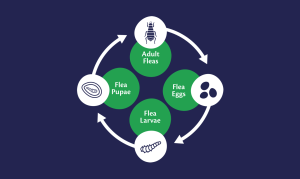It’s really important for cat owners to be aware of the issues associated with fleas and ticks and understand the importance of treating cats regularly.

Fleas and ticks can be a right pain for all pets and their owners.
Although a problem for all, cats (and especially outdoor ones which are free to explore) can be particularly susceptible to parasites. Because they’re sociable animals, one of the main causes of fleas in cats is in their socialising with other people’s cats outside in nearby streets.
Collars and spot-on treatments for fleas can go a long way towards getting rid of fleas, but it should be used alongside responsible pet ownership in discouraging our pets from roaming in long grass or the countryside where possible. Simple steps such as preventing cats from roaming can make a big difference in limiting parasite exchange.
What’s the difference between fleas and ticks?
Fleas are small blood sucking parasites which feed on animals. Because they’re wingless, their main way of getting around is by jumping – sometimes distances of 100 times their own body length! Although that sounds pretty impressive, they’ll jump onto your cat whilst outside, and once they’ve latched on, they’ll then start feeding.
They can be hard to spot, but if you see fleas on your pet then they’ll definitely be in your home too. Even just one female flea can lay up to 50 eggs a day, meaning a single flea can easily infest your pet and your home.
In addition to making your pet uncomfortable, fleas can also lead to flea allergy dermatitis and even anaemia. Fleas can also carry tapeworm larvae, which your pet can become infested by accidentally ingesting fleas whilst grooming themselves.
And although ticks won’t necessarily infest your home, they can be just as menacing and can be potentially dangerous as they can spread blood-borne diseases after they’ve latched onto your pet and sucked their blood for hours at a time.
Symptoms of fleas and ticks on cats
Fleas can be an itchy pain. That’s why repeated scratching is often the first sign of an infestation, with constant itching also leading to hair loss or irritated skin which can be another sign. They’re really small (often the size of a poppy seed) so can be hard to spot, but you might see them on their fur or if you use a flea comb.
Whilst not necessarily an issue for cats, ticks can cause Lyme Disease in both humans and dogs – a potentially life threatening illness, so it’s definitely worth being extra careful.
How to check your cat for fleas and ticks
If you live in a tick-prevalent area it’s worth checking your pet regularly by running your fingers through their coat feeling for a little lump, look inside their ears and between their toes. They are usually quite easy to see and feel.
Check your pet for fleas on the neck area, behind the ears, at the base of the tail and fur on the tummy. Place your pet on some white paper, then comb them with a flea comb. Flecks of black which change to red when you wet the paper is evidence of flea dirt.
How to treat and prevent fleas and ticks on your cat and in the home
If you find a tick on your pet, it’s best to remove it as soon as possible as it can spread disease. If you’ve never removed a tick before, or you’re unsure how to do it, you should consult your vet who can show you – if you don’t remove the tick properly you risk leaving the head buried beneath the skin, which can result in a nasty abscess.
And as for fleas… Most pet owners know they should treat their cat for fleas and ticks on a regular basis. But did you know that the fleas you see on your pet only makes up 5% of the flea infestation? The remaining 95% are in the home.
The importance of treatment in the home
Making sure you treat both your pet and your home is a vital step, because it will ensure you treat the whole problem and fully eradicate them. Without treating the home, your cat may continue to get re-infested with fleas until you do so.
To provide complete protection for your cat and your home, your flea treatments need to include two ingredients: an insecticide to kill the adult fleas and an Insect Growth Regulator (IGR) which targets flea eggs and flea larvae and stops their life cycle.

If you’ve spotted fleas or ticks, it’s really important to introduce a treatment product routine, as soon as possible:
If you’ve spotted fleas:
Step 1: Treat your cat for fleas with a fast-acting treatment
Step 2: Then treat your home with a Bob Martin Home flea product (such as a spray, fogger or powder) and then vacuum, before washing your bedding and spraying your home with preventive treatments.
If you find a tick on your pet, it’s best to remove it as soon as possible as it can spread disease. If you’ve never removed a tick before, or you’re unsure how to do it, you should consult your vet who can show you – if you don’t remove the tick properly you risk leaving the head buried beneath the skin, which can result in a nasty abscess.
Bob Martin’s Clear and Clear Plus range of spot ons and tablet treatments for your cat, alongside Bob Martin Clear Home Sprays, Foggers, Powders or Bombs, will kill fleas and flea eggs, ticks and dust mites, protect your home for up to 12 months by breaking the flea’s life cycle.

